Energy Management and Optimization of a PV/Diesel/Battery Hybrid Energy System Using a Combined Dispatch Strategy
Abstract
:1. Introduction
2. Methodology
- Selected site specifications and load demand data
- Metrological data (solar radiation and temperature)
- Hybrid power system components
- Mathematical representation
- System operational control
2.1. Specification and Load Profile of the Selected Site
2.2. Solar Resource and Temperature
- The solar radiation and clearance index data for the selected village (33° N latitude and 44° E longitude) are presented in Figure 4. The annual average solar radiation is 5.02 kWh/m2/day, maximum solar radiation (7.56 kWh/m2/day) is recorded in June, and the minimum solar radiation (2.62 kWh/m2/day) is recorded in December. The amount of solar radiation received by the area is relatively high, which indicates that the solar energy system is an attractive power source.
- The ambient temperature plays a vital role in the performance of PV modules. Therefore, accurate measurement of ambient temperature data is essential. The monthly average ambient temperature for the chosen area is illustrated in Figure 5. The summer season shows the highest ambient temperature, at 36.15 °C in July, and the winter season records the lowest ambient temperature, at 9.77 °C in January. In HOMER software, the ambient temperature is taken into consideration when calculating the output PV power.
2.3. System Components
2.4. Mathematical Representation
2.4.1. Output PV Power
2.4.2. Economic Model
2.5. Control Strategy
2.5.1. Load Following Strategy
- ➢
- The first case is when the output PV power is equal to the load power. Here, the PV power meets the load demand, the batteries do not draw any energy, and the generator stays off. In this case, no excess power exists.
- ➢
- The second case takes place when the output PV power is higher than the load power. The PV feeds the load resulting in excess power. In this case, the excess power will be damped if the battery is fully charged. In the case where the battery is not fully charged, the excess PV power is used to charge the battery. The generator also does not work in this case.
- ➢
- The last case is when the PV power is lower than the load power. The two possible subcases are as follows:
- If SOC = SOCmin, the generator works to feed the net load (load minus renewable power). The generator provides only enough power to satisfy the net load without charging the battery. It is important to mention that if the minimum generator loading output power is higher than the net load, the generator works to feed the load and the excess power from the PV charges the battery.
- If SOC > SOCmin, a cost of discharging the battery is computed and compared with the cost of turning on the generator that operates only to serve the net load. If the battery discharging cost is higher than the cost of turning on a generator, then the battery would not be discharged while the generator runs and produce enough power to meet the load demand without charging the battery. Otherwise, the battery is discharged. The following equations explain the cost of each decision:
- The cost of discharging the batteries is calculated using the following equation [16,57]:Cbatt,wear is the battery wear cost ($/kWh), which is given by [16,57]:where Cbatt,rep is the battery replacement cost ($), Nbatt is the number of batteries in the storage bank, Qlife is the single battery throughput (kWh), and ηrt is the battery round trip efficiency (%).
2.5.2. Cycle Charging Strategy
2.5.3. Combined Dispatch Strategy
- ➢
- The first decision takes place when the generator provides only enough electricity to satisfy the net load without charging the battery.
- ➢
- In the second decision, the generator meets the net load and charges the battery with the excess power.
- ➢
- The third decision is feeding the net load by the battery alone.
- ➢
- If the PV power is equal to or higher than the load demand, the power flow is the same for that of LF and CC strategies.
- ➢
- If the PV power is less than the load power, the two possible subcases are as follows:
- If SOC = SOCmin, the controller compares the cost of running the generator to produce only enough power to feed the net load without charging the battery with the cost of running the generator at its maximum capacity to serve the net load and charge the battery with the excess electricity. A decision is made based on the least cost dispatch decision.
- If SOC > SOCmin, three decision costs are compared with each other, which are: the cost of turning on the generator that operates only to serve the net load without charging the battery, the cost of running the generator at its maximum capacity to serve the net load and charge the battery, and the cost of discharging the battery. The power flow solution is taken place according to the minimum cost decision.
3. Results and Discussion
3.1. Optimization Results
3.2. Economic Analysis of the System under the Three Dispatch Strategies
- The lowest capital cost was achieved by using the CC strategy ($32,537), followed by the CD strategy ($50,042). The system under CC had a capital cost of $64,779, which was the highest among the systems compared, because of the large sizes of renewable components.
- Once installed, the PV, converter, and batteries under all strategies were inexpensive to operate and maintain compared with the diesel generator, which contributed most of the total O&M cost. The CD strategy was found to have the lowest O&M cost, which was $18,172, i.e., 37.7% and 21.9% lower than those of LF and CC, respectively.
- The replacement cost of the LF, CC, and CD strategies were $9005, $8457, and $5135, respectively. The CD strategy had the lowest cost because it depended less on the diesel generator, which led to making this strategy have the highest generator lifetime as compared to other strategies.
- The fuel cost of the CD strategy was $42,016, which was lower than that of the other strategies, because of the relatively low fuel consumption in this strategy. The fuel costs of the LF and CC strategies were $42,742 and $55,182, respectively.
- The salvage costs over the project lifetime of the LF, CC, and CD strategies were estimated to be $–6974, $–3727, and $–5174, respectively; these costs originated from the remaining life of the system components.
3.3. Environmental Assessment
3.4. Energy Balance of the Optimized Systems
- LF strategy: Figure 14 shows the energy balance and battery SOC of the proposed HES under LF strategy. At the start of the day (00:00–05:30), the battery discharged its power to supply the load alone. At 05:30, the PV array began producing power, but it was not enough to meet the load; therefore, the batteries continued to discharge their power for half an hour. At 06:00, the batteries reached their minimum SOC, so the generator worked to meet the load while the batteries were charged by the excess power from PV until 07:00. For the period between 07:00 and 13:30, PV power was sufficient to fulfill all demand and charge the battery. From 13:30 to 16:30 the generator restarted and worked together with the PV. From 16:30 to 18:30, the batteries discharged to help the PV and the generator in satisfying the load. At 18:30, the PV power became zero, and the load was met by the generator and the batteries for the rest of the day.
- CC strategy: The energy balance and battery SOC of the proposed HES under CC strategy is depicted in Figure 15. For the first few hours (00:00–05:30), the load was served by the battery, similar to the LF strategy. From 05:30 to 07:00, both the PV and battery shared to satisfy the load. From 07:00 to 10:00, the generator produced power so that both the PV and generator could serve the load. Since it was a cycle-charging scheme, the excess power of the generator was used to charge the battery. The load was satisfied by the PV, which also charged the batteries from 10:00 to 12:30. At 12:30, the PV output showed a decrease in its output power; therefore, the batteries discharged their power to compensate for the required power and continued to do so until 15:30. At 15:30, the generator worked with the PV to feed the load and charge the batteries. The PV output fell to zero at 18:30 and the generator continued to feed the load for the remaining time of the day.
- CD strategy: Figure 16 presents the energy balance and battery SOC of the proposed HES under CD strategy. As in the LF and CC strategies, the load was served by the battery alone from 00:00 until 05:30. From 05:30 until 15:30, the PV supplied the load and charged the battery during the high solar radiation hours, while the batteries discharged their power to share with the PV in satisfying the load during the low solar radiation hours. Around 15:30, the generator operated at its maximum rated capacity to share in meeting the load with the PV and charged the batteries by the excess power. This case represented the CC strategy, which continued until 18:30. After 18:30, the PV output became zero, and the generator produced only enough power to satisfy the load without charging the battery. This case referred to the LF strategy and continued until 19:30. The CC strategy took place again from 19:30 to 21:30. In the period from 21:30 to 22:00, the generator and the batteries shared to feed the load. At 22:00, the generator turned off, and the load was served by the batteries for the remaining time.
3.5. Sensitivity Analysis
3.5.1. Battery Minimum SOC
3.5.2. Time Step
3.5.3. Solar Radiation
3.5.4. Diesel Fuel Price
3.5.5. Load Consumption Growth
4. Conclusions
Author Contributions
Funding
Acknowledgments
Conflicts of Interest
References
- Mehrpooya, M.; Mohammadi, M.; Ahmadi, E. Techno-economic-environmental study of hybrid power supply system: A case study in Iran. Sustain. Energy Technol. Assess. 2018, 25, 1–10. [Google Scholar] [CrossRef]
- Owusu, P.A.; Asumadu-Sarkodie, S. A review of renewable energy sources, sustainability issues and climate change mitigation. Cogent. Eng. 2016, 3, 1167990. [Google Scholar] [CrossRef]
- Ramli, M.A.; Hiendro, A.; Twaha, S. Economic analysis of PV/diesel hybrid system with flywheel energy storage. Renew. Energy 2015, 78, 398–405. [Google Scholar] [CrossRef]
- Moreira, D.; Pires, J.C. Atmospheric CO2 capture by algae: Negative carbon dioxide emission path. Bioresour. Technol. 2016, 215, 371–379. [Google Scholar] [CrossRef] [PubMed]
- Kim, H.; Bae, J.; Baek, S.; Nam, D.; Cho, H.; Chang, H. Comparative analysis between the government micro-grid plan and computer simulation results based on real data: The practical case for a South Korean Island. Sustainability 2017, 9, 197. [Google Scholar] [CrossRef]
- REN21. Renewables 2018 Global Status Report; REN21 Secretariat: Paris, France, 2018; ISBN 978-3-9818911-3-3. [Google Scholar]
- Shahzad, M.K.; Zahid, A.; Rashid, T.U.; Rehan, M.A.; Ali, M.; Ahmad, M. Techno-economic feasibility analysis of a solar-biomass off grid system for the electrification of remote rural areas in Pakistan using HOMER software. Renew. Energy 2017, 106, 264–273. [Google Scholar] [CrossRef]
- Shi, B.; Wu, W.; Yan, L. Size optimization of stand-alone PV/wind/diesel hybrid power generation systems. J. Taiwan Inst. Chem. Eng. 2017, 73, 93–101. [Google Scholar] [CrossRef]
- Nag, A.K.; Sarkar, S. Modeling of hybrid energy system for futuristic energy demand of an Indian rural area and their optimal and sensitivity analysis. Renew. Energy 2018, 118, 477–488. [Google Scholar] [CrossRef]
- Arul, P.; Ramachandaramurthy, V.K.; Rajkumar, R. Control strategies for a hybrid renewable energy system: A review. Renew. Sustain. Energy Rev. 2015, 42, 597–608. [Google Scholar] [CrossRef]
- Strnad, I.; Prenc, R. Optimal sizing of renewable sources and energy storage in low-carbon microgrid nodes. Electr. Eng. 2017, 100, 1661–1674. [Google Scholar] [CrossRef]
- Cheng, L.; Wang, W.; Wei, S.; Lin, H.; Jia, Z. An improved energy management strategy for hybrid energy storage system in light rail vehicles. Energies 2018, 11, 423. [Google Scholar] [CrossRef]
- Li, H.; Eseye, A.T.; Zhang, J.; Zheng, D. Optimal energy management for industrial microgrids with high-penetration renewables. Prot. Control Mod. Power Syst. 2017, 2. [Google Scholar] [CrossRef]
- Olatomiwa, L.; Mekhilef, S.; Ismail, M.; Moghavvemi, M. Energy management strategies in hybrid renewable energy systems: A review. Renew. Sustain. Energy. Rev. 2016, 62, 821–835. [Google Scholar] [CrossRef]
- Vivas, F.; Heras, A.D.L.; Segura, F.; Andújar, J. A review of energy management strategies for renewable hybrid energy systems with hydrogen backup. Renew. Sustain. Energy. Rev. 2018, 82, 126–155. [Google Scholar] [CrossRef]
- Farret, F.A.; Simões, M. Godoy Integration of Renewable Sources of Energy; John Wiley & Sons, Inc.: Hoboken, NJ, USA, 2018. [Google Scholar]
- Zambrana, M.N.F.V. System Design and Analysis of a Renewable Energy Source Powered Microgrid. M.Sc. Thesis, University of Maryland, College Park, MD, USA, 2018. [Google Scholar]
- Sawle, Y.; Gupta, S.; Bohre, A.K. Optimal sizing of standalone PV/Wind/Biomass hybrid energy system using GA and PSO optimization technique. Energy Procedia 2017, 117, 690–698. [Google Scholar] [CrossRef]
- Hosseinalizadeh, R.; Shakouri, G.H.; Amalnick, M.S.; Taghipour, P. Economic sizing of a hybrid (PV–WT–FC) renewable energy system (HRES) for stand-alone usages by an optimization-simulation model: Case study of Iran. Renew. Sustain. Energy Rev. 2016, 57, 1657. [Google Scholar] [CrossRef]
- Olatomiwa, L.; Mekhilef, S.; Huda, A.S.N.; Sanusi, K. Techno-economic analysis of hybrid PV-diesel-battery and PV-wind-diesel-battery power systems for mobile BTS: The way forward for rural development. Energy Sci. Eng. 2015, 3, 271–285. [Google Scholar] [CrossRef]
- Ajlan, A.; Tan, C.W.; Abdilahi, A.M. Assessment of environmental and economic perspectives for renewable-based hybrid power system in Yemen. Renew. Sustain. Energy Rev. 2017, 75, 559–570. [Google Scholar] [CrossRef]
- Hsu, D.; Kang, L. Dispatch Analysis of Off-Grid Diesel Generator-Battery Power Systems. Int. J. Emerg. Electr. Power Syst. 2014, 15. [Google Scholar] [CrossRef]
- Zobaa, A.F.; Bansal, R.C. Handbook of Renewable Energy Technology; World Scientific Pub. Co.: Singapore, 2011. [Google Scholar]
- Jung, T.; Kim, D.; Moon, J.; Lim, S. A scenario analysis of solar photovoltaic grid parity in the Maldives: The case of Malahini resort. Sustainability 2018, 10, 4045. [Google Scholar] [CrossRef]
- Brenna, M.; Foiadelli, F.; Longo, M.; Abegaz, T. Integration and optimization of renewables and storages for rural electrification. Sustainability 2016, 8, 982. [Google Scholar] [CrossRef]
- Jiang, F.; Xie, H.; Ellen, O. Hybrid energy system with optimized storage for improvement of sustainability in a small town. Sustainability 2018, 10, 2034. [Google Scholar] [CrossRef]
- Mazzola, S.; Astolfi, M.; Macchi, E. A detailed model for the optimal management of a multigood microgrid. Appl. Energy 2015, 154, 862–873. [Google Scholar] [CrossRef]
- Halabi, L.M.; Mekhilef, S.; Olatomiwa, L.; Hazelton, J. Performance analysis of hybrid PV/diesel/battery system using HOMER: A case study Sabah, Malaysia. Energy Convers. Manag. 2017, 144, 322–339. [Google Scholar] [CrossRef]
- Ansong, M.; Mensah, L.D.; Adaramola, M.S. Techno-economic analysis of a hybrid system to power a mine in an off-grid area in Ghana. Sustain. Energy Technol. Assess. 2017, 23, 48–56. [Google Scholar] [CrossRef]
- Sigarchian, S.G.; Paleta, R.; Malmquist, A.; Pina, A. Feasibility study of using a biogas engine as backup in a decentralized hybrid (PV/wind/battery) power generation system—Case study Kenya. Energy 2015, 90, 1830–1841. [Google Scholar] [CrossRef]
- Rezzouk, H.; Mellit, A. Feasibility study and sensitivity analysis of a stand-alone photovoltaic–diesel–battery hybrid energy system in the north of Algeria. Renew. Sustain. Energy. Rev. 2015, 43, 1134–1150. [Google Scholar] [CrossRef]
- Madziga, M.; Rahil, A.; Mansoor, R. Comparison between three off-grid hybrid systems (solar photovoltaic, diesel generator and battery storage system) for electrification for Gwakwani village, South Africa. Environments 2018, 5, 57. [Google Scholar] [CrossRef]
- Upadhyay, S.; Sharma, M. Development of hybrid energy system with cycle charging strategy using particle swarm optimization for a remote area in India. Renew. Energy 2015, 77, 586–598. [Google Scholar] [CrossRef]
- Rajbongshi, R.; Borgohain, D.; Mahapatra, S. Optimization of PV-biomass-diesel and grid base hybrid energy systems for rural electrification by using HOMER. Energy 2017, 126, 461–474. [Google Scholar] [CrossRef]
- Amutha, W.M.; Rajini, V. Cost benefit and technical analysis of rural electrification alternatives in southern India using HOMER. Renew. Sustain. Energy. Rev. 2016, 62, 236–246. [Google Scholar] [CrossRef]
- Sen, R.; Bhattacharyya, S.C. Off-grid electricity generation with renewable energy technologies in India: An application of HOMER. Renew. Energy 2014, 62, 388–398. [Google Scholar] [CrossRef]
- Singh, A.; Baredar, P.; Gupta, B. Techno-economic feasibility analysis of hydrogen fuel cell and solar photovoltaic hybrid renewable energy system for academic research building. Energy Convers. Manag. 2017, 145, 398–414. [Google Scholar] [CrossRef]
- Kansara, B.U.; Parekh, B.R. Dispatch, control strategies and emissions for isolated wind-diesel hybrid power system. Int. J. Innov. Technol. Explor. Eng. 2013, 2, 152–156. [Google Scholar]
- Eu-Tjin, C.; Huat, C.K.; Seng, L.Y. Control strategies in energy storage system for standalone power systems. In Proceedings of the 4th IET Clean Energy and Technology Conference, Kuala Lumpur, Malaysia, 14–15 November 2016. [Google Scholar]
- Markovic, M.; Nedic, Z.; Nafalski, A. Microgrid solutions for insular power systems in the outback of Australia. Masz. Elektr. Zesz. Probl. 2016, 109, 103–107. [Google Scholar]
- Kansara, B.U.; Parekh, B.R. Penetration of renewable energy resources based dispatch strategies for isolated hybrid systems. Int. J. Electr. Electron. Eng. Res. 2013, 3, 121–130. [Google Scholar]
- Saraswat, S.K.; Rao, K.V.S. 10 kW solar photovoltaic—Diesel hybrid energy system for different solar zones of India. In Proceedings of the 2016 International Conference on Emerging Technological Trends (ICETT), Kollam, India, 21–22 October 2016. [Google Scholar]
- Fodhil, F.; Hamidat, A.; Nadjemi, O. Energy control strategy analysis of hybrid power generation system for rural Saharan community in Algeria. In Artificial Intelligence in Renewable Energetic Systems Lecture Notes in Networks and Systems; Springer: Cham, Switzerland, 2017; pp. 108–120. [Google Scholar]
- Shoeb, M.; Shafiullah, G. Renewable energy integrated islanded microgrid for sustainable irrigation—A Bangladesh perspective. Energies 2018, 11, 1283. [Google Scholar] [CrossRef]
- Ghenai, C.; Bettayeb, M. Optimized design and control of an off grid solar PV/hydrogen fuel cell power system for green buildings. IOP Conf. Ser. Earth Environ. Sci. 2017, 93, 012073. [Google Scholar] [CrossRef] [Green Version]
- Maatallah, T.; Ghodhbane, N.; Nasrallah, S.B. Assessment viability for hybrid energy system (PV/wind/diesel) with storage in the northernmost city in Africa, Bizerte, Tunisia. Renew. Sustain. Energy Rev. 2016, 59, 1639–1652. [Google Scholar] [CrossRef]
- Islam, M.S.; Akhter, R.; Rahman, M.A. A thorough investigation on hybrid application of biomass gasifier and PV resources to meet energy needs for a northern rural off-grid region of Bangladesh: A potential solution to replicate in rural off-grid areas or not? Energy 2018, 145, 338–355. [Google Scholar] [CrossRef]
- Hassan, Q.; Jaszczur, M.; Abdulateef, J. Optimization of PV/wind/diesel hybrid power system in HOMER for rural electrification. J. Phys. Conf. Ser. 2016, 745, 032006. [Google Scholar] [CrossRef]
- Surface Meteorology and Solar Energy. Available online: https://eosweb.larc.nasa.gov/cgi-bin/sse/homer.cgi (accessed on 15 August 2018).
- Garni, H.Z.A.; Awasthi, A.; Ramli, M.A. Optimal design and analysis of grid-connected photovoltaic under different tracking systems using HOMER. Energy Convers. Manag. 2018, 155, 42–57. [Google Scholar] [CrossRef]
- Bimble Solar. Available online: https://www.bimblesolar.com/NiFe200ah (accessed on 5 September 2018).
- Aziz, A.S.; Tajuddin, M.F.N.; Adzman, M.R. Feasibility analysis of PV/wind/battery hybrid power generation: A case study. Int. J. Renew. Energy Res. 2018, 8, 661–671. [Google Scholar]
- Nacer, T.; Hamidat, A.; Nadjemi, O.; Bey, M. Feasibility study of grid connected photovoltaic system in family farms for electricity generation in rural areas. Renew. Energy 2016, 96, 305–318. [Google Scholar] [CrossRef]
- Mamaghani, A.H.; Escandon, S.A.A.; Najafi, B.; Shirazi, A.; Rinaldi, F. Techno-economic feasibility of photovoltaic, wind, diesel and hybrid electrification systems for off-grid rural electrification in Colombia. Renew. Energy 2016, 97, 293–305. [Google Scholar] [CrossRef]
- Alharthi, Y.; Siddiki, M.; Chaudhry, G. Resource Assessment and Techno-Economic Analysis of a Grid-Connected Solar PV-Wind Hybrid System for Different Locations in Saudi Arabia. Sustainability 2018, 10, 3690. [Google Scholar] [CrossRef]
- Alam, M.; Bhattacharyya, S. Decentralized renewable hybrid mini-grids for sustainable electrification of the off-grid coastal areas of Bangladesh. Energies 2016, 9, 268. [Google Scholar] [CrossRef]
- Rendall, C.O. Economic Feasibility Analysis of Microgrids in Norway: An Application of HOMER Pro. Master’s Thesis, Norwegian University of Life Sciences, Ås, Norway, 2018. [Google Scholar]
- HOMER Energy Index. Available online: https://www.homerenergy.com/products/pro/docs/3.11/index.html (accessed on 25 September 2018).
- Maheri, A. Multi-objective design optimisation of standalone hybrid wind-PV-diesel systems under uncertainties. Renew. Energy 2014, 66, 650–661. [Google Scholar] [CrossRef] [Green Version]
- Tharani, K.L.; Dahiya, R. Choice of battery energy storage for a hybrid renewable energy system. Turk. J. Electr. Eng. Comput. Sci. 2018, 26, 666–676. [Google Scholar] [CrossRef]
- Fazelpour, F.; Soltani, N.; Rosen, M.A. Economic analysis of standalone hybrid energy systems for application in Tehran, Iran. Int. J. Hydrogen Energy 2016, 41, 7732–7743. [Google Scholar] [CrossRef]
- Wang, Y.; Jiao, X.; Sun, Z.; Li, P. Energy Management strategy in consideration of battery health for PHEV via stochastic control and particle swarm optimization algorithm. Energies 2017, 10, 1894. [Google Scholar] [CrossRef]
- Bordin, C.; Anuta, H.O.; Crossland, A.; Gutierrez, I.L.; Dent, C.J.; Vigo, D. A linear programming approach for battery degradation analysis and optimization in offgrid power systems with solar energy integration. Renew. Energy 2017, 101, 417–430. [Google Scholar] [CrossRef] [Green Version]
- Rivera-Barrera, J.; Muñoz-Galeano, N.; Sarmiento-Maldonado, H. SoC estimation for lithium-ion batteries: Review and future challenges. Electronics 2017, 6, 102. [Google Scholar] [CrossRef]
- Galad, M.; Spanik, P.; Cacciato, M.; Nobile, G. Comparison of common and combined state of charge estimation methods for VRLA batteries. In Proceedings of the ELEKTRO, Strbske Pleso, Slovakia, 16–18 May 2016. [Google Scholar]
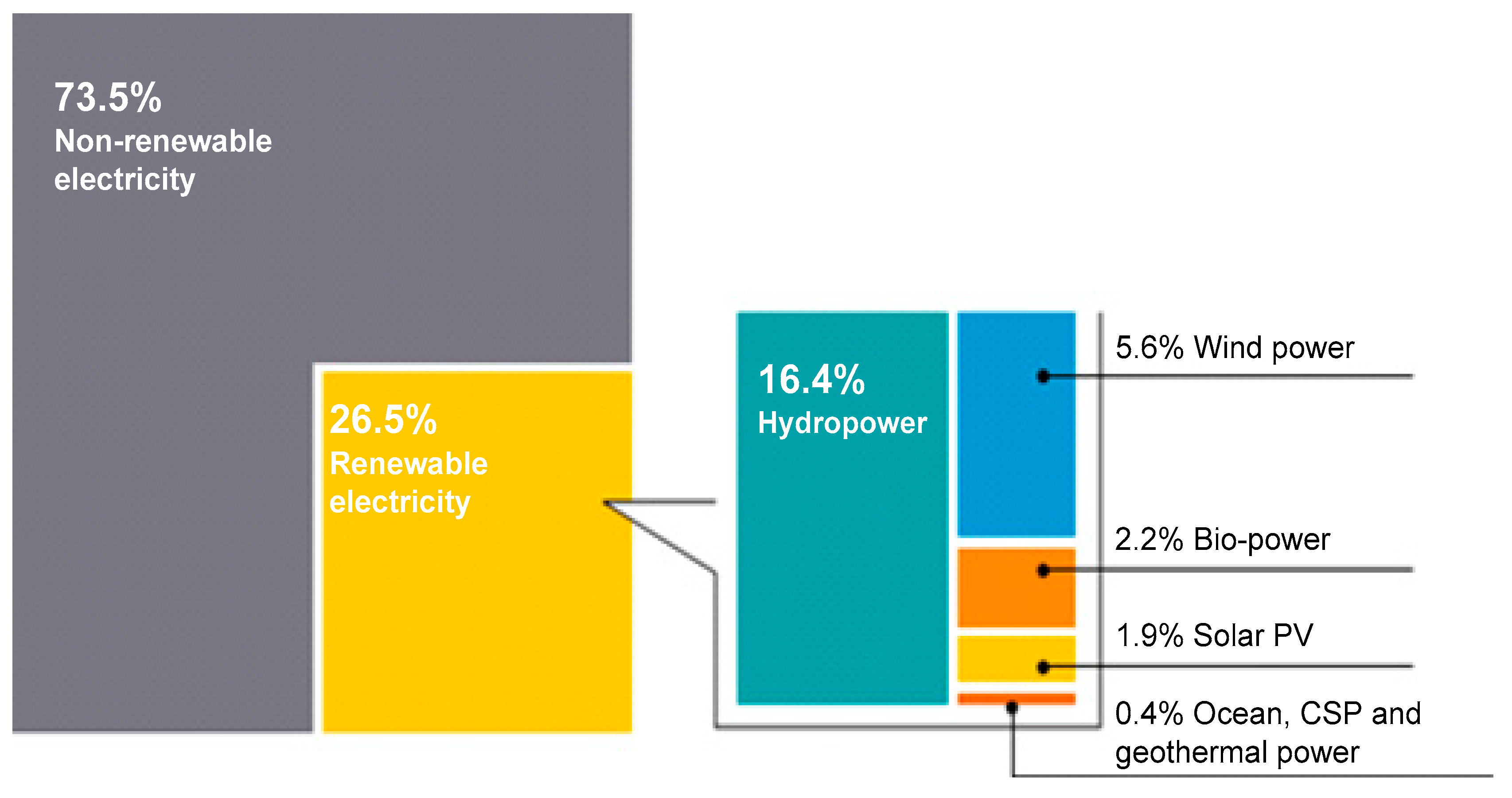
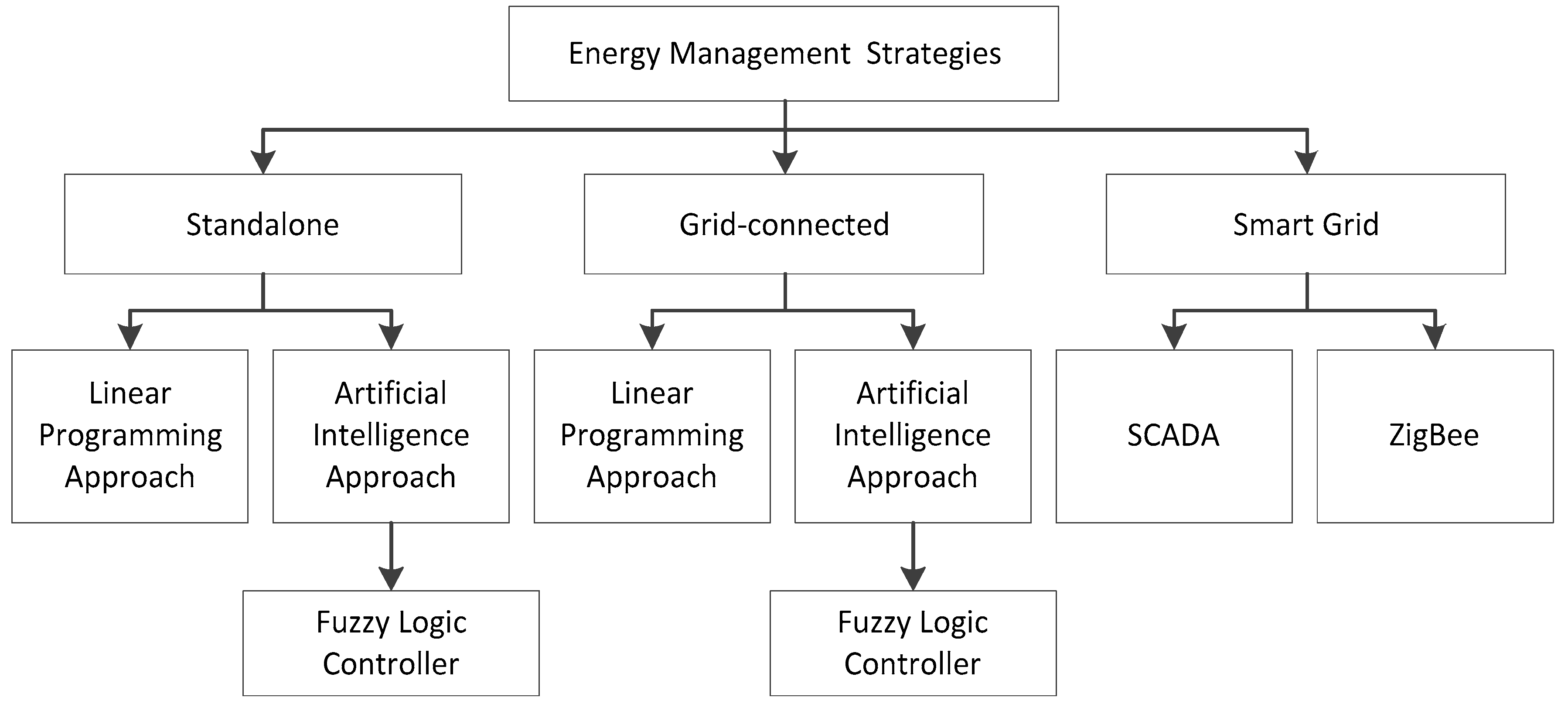


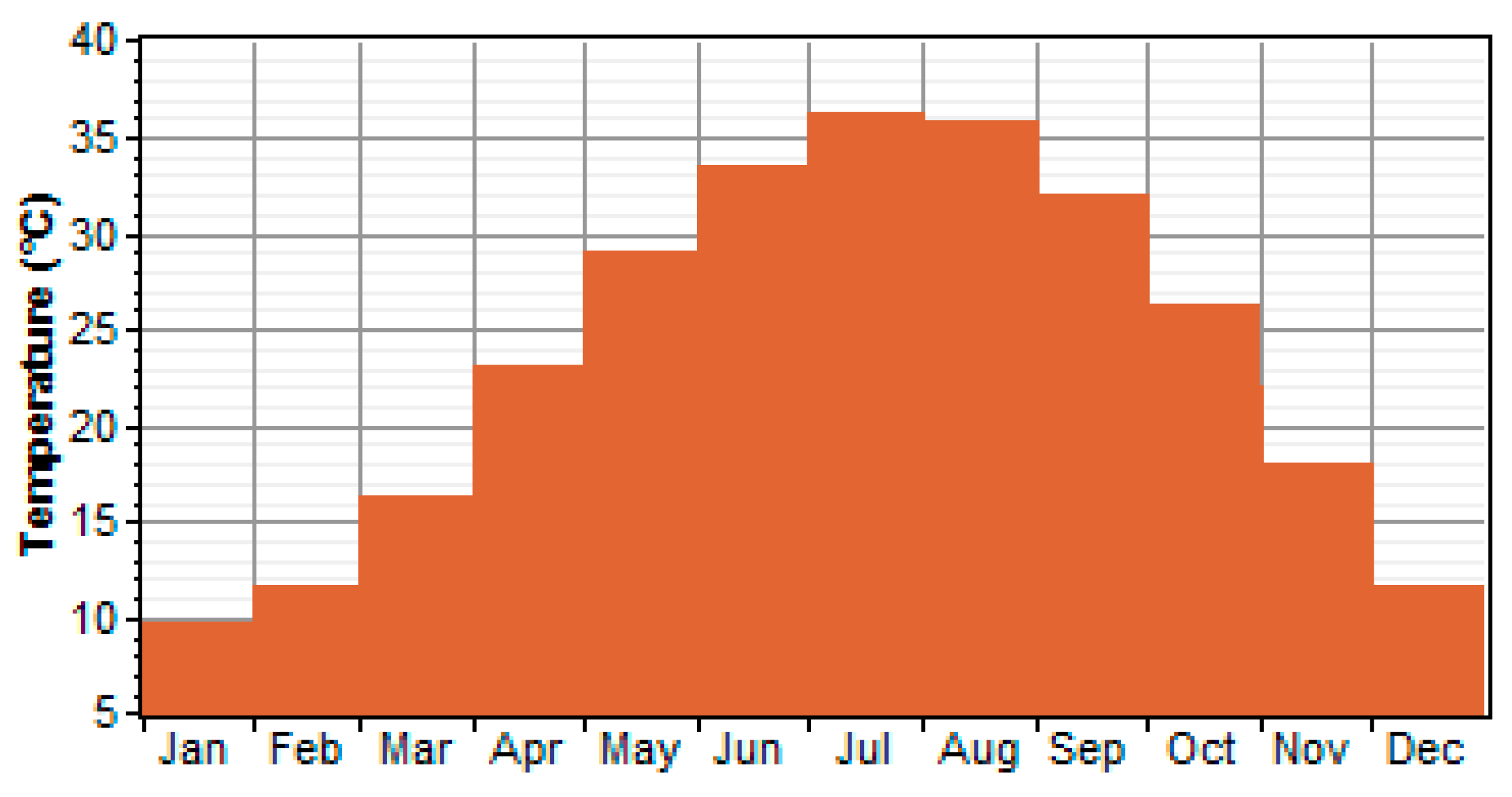

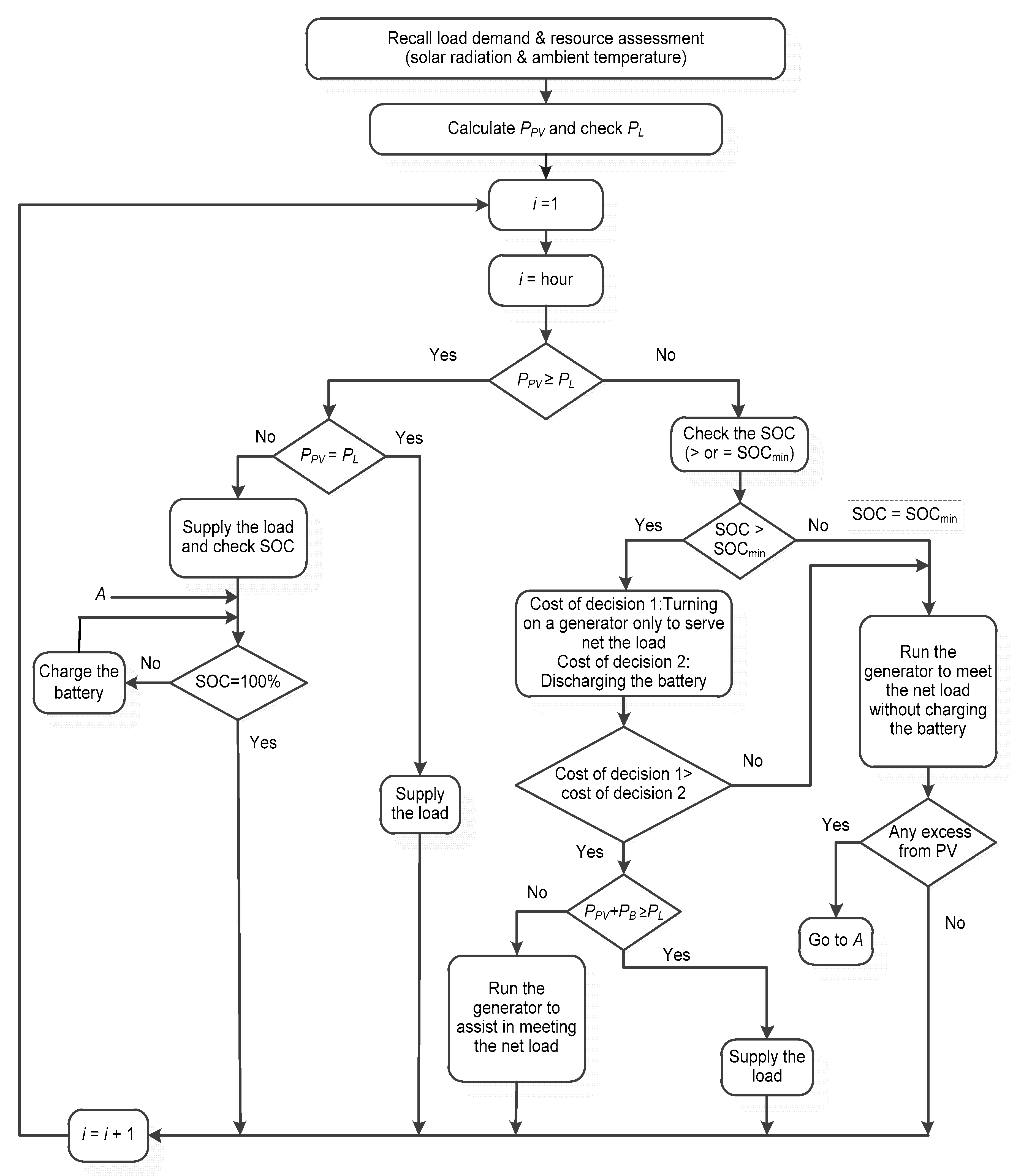
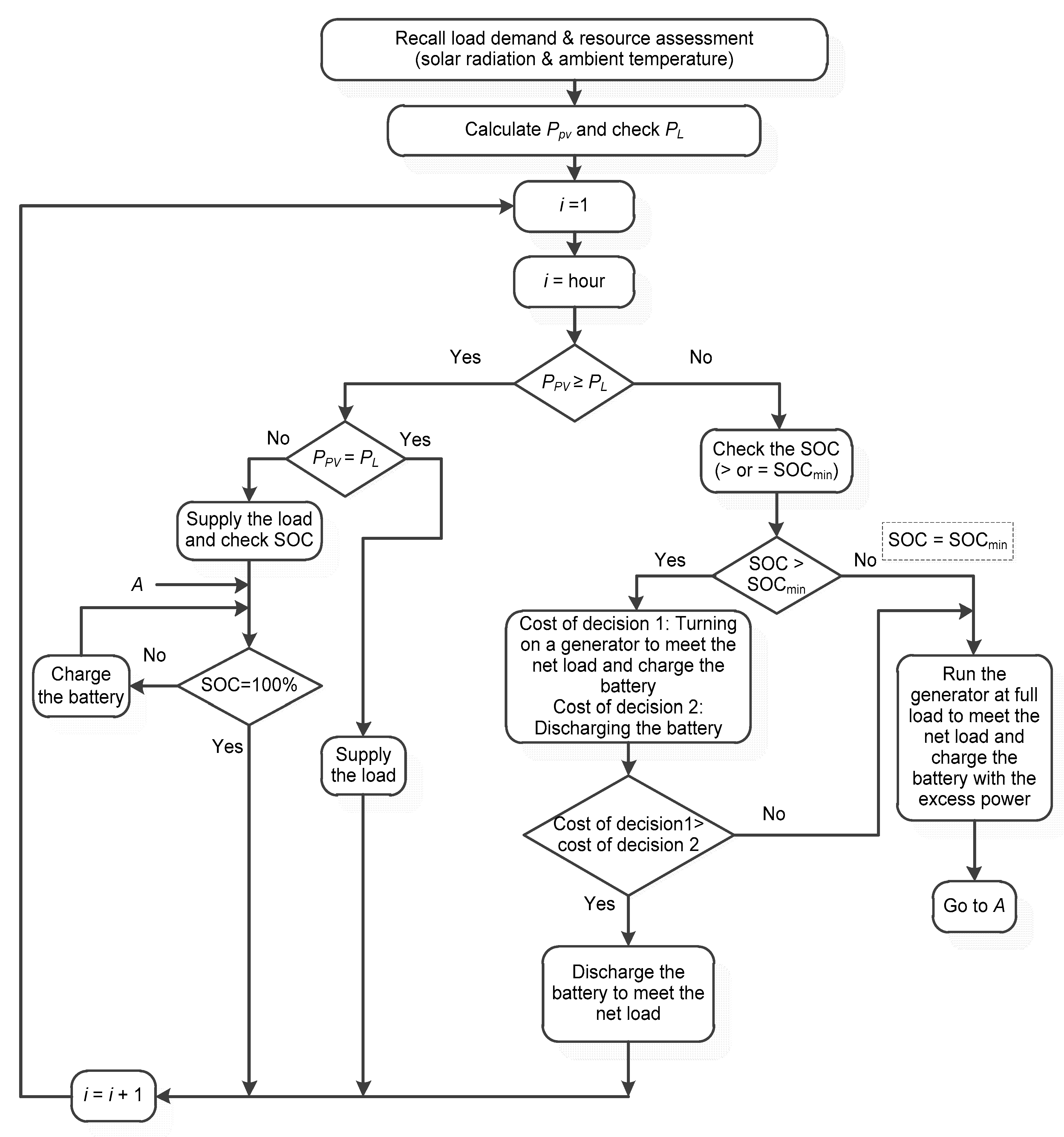


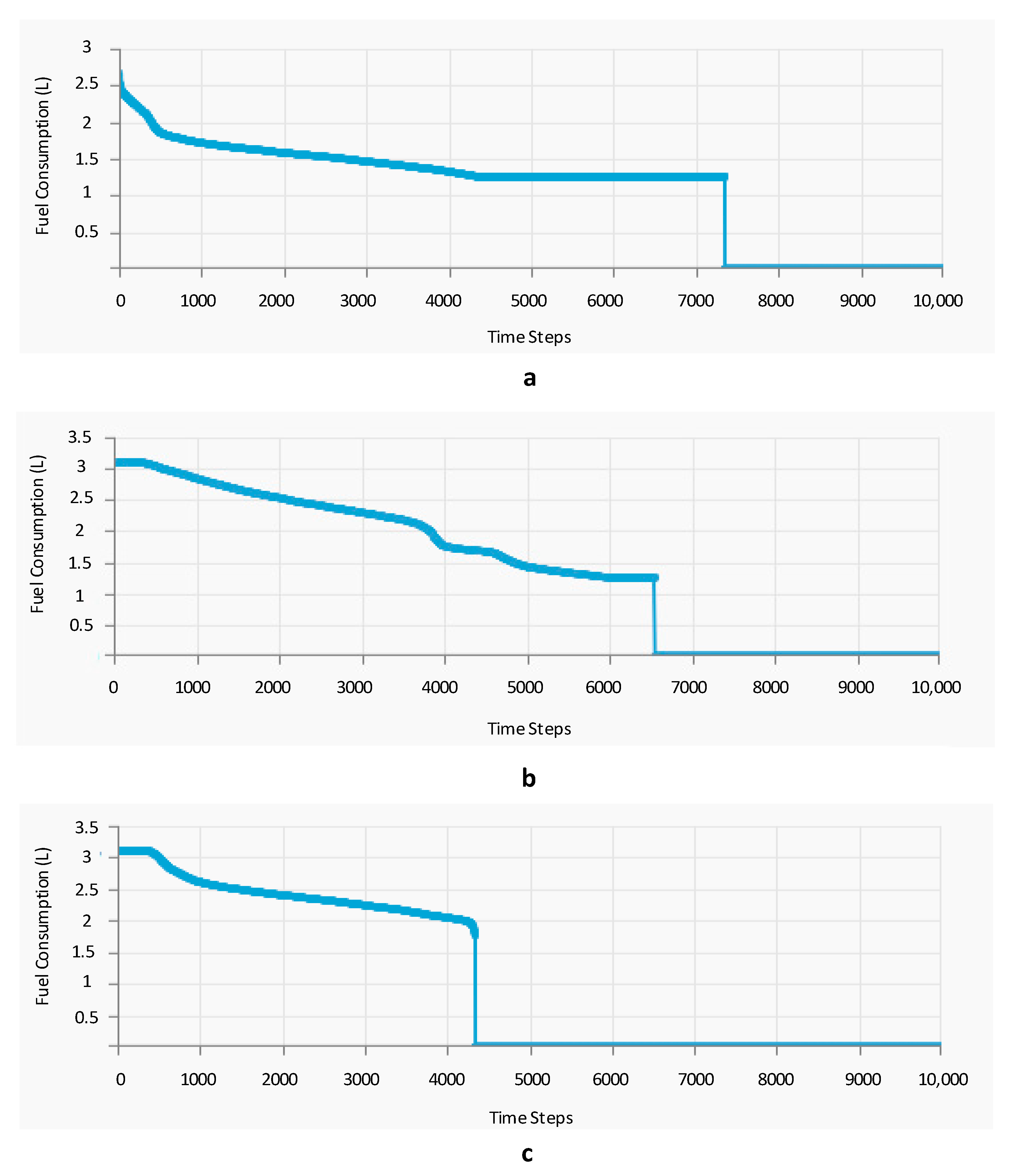






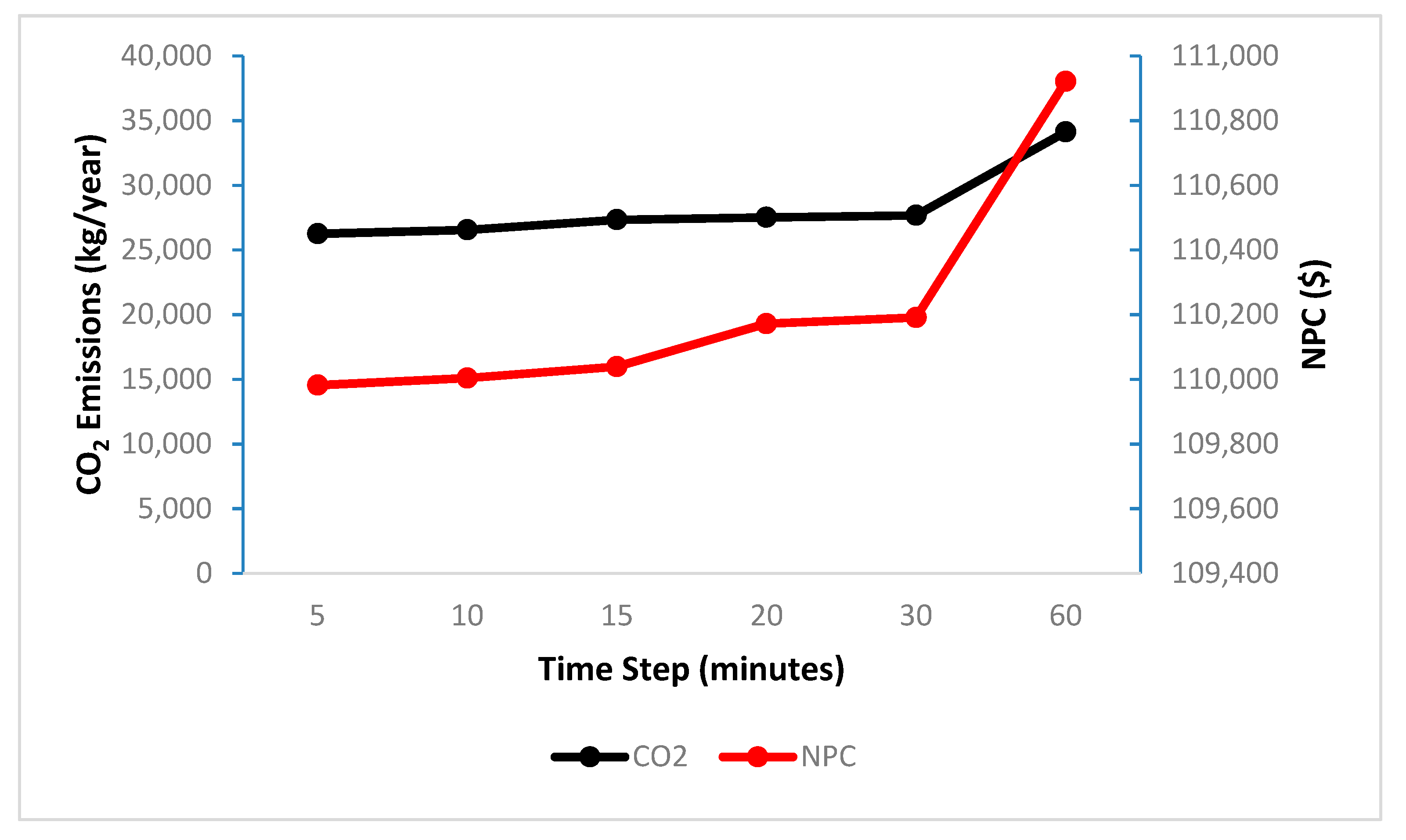
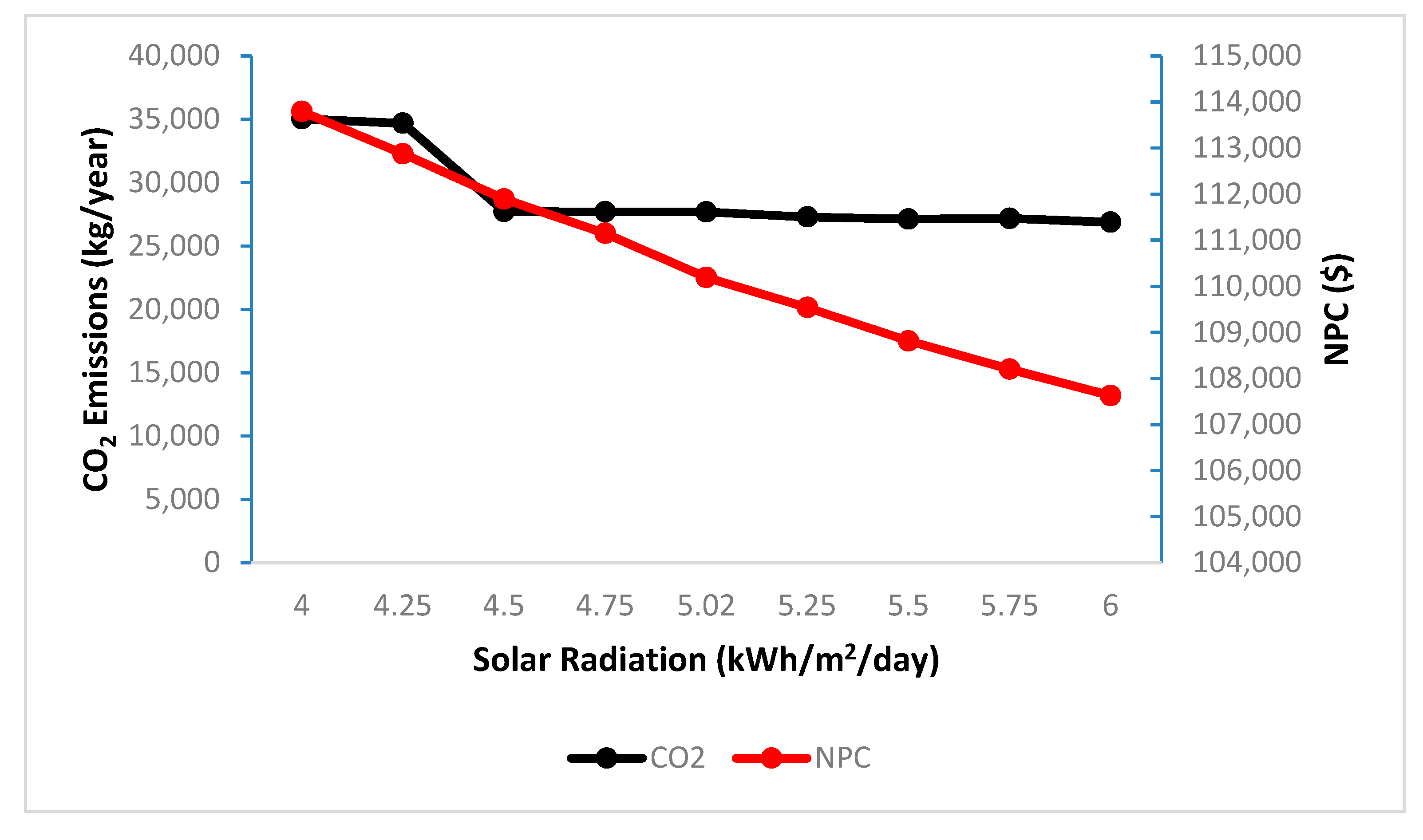


| Reference | Description | Specification |
|---|---|---|
| [50] | 1. PV system | |
| Tracking system | Fixed | |
| Nominal operating cell temperature | 47 °C | |
| Temperature coefficient | −0.4%/°C | |
| Efficiency at standard test condition | 18% | |
| Derating factor | 80% | |
| Capital cost | $640/kW | |
| Operating and maintenance cost | $10/kW/year | |
| Cost of replacement | $640/kW | |
| Lifetime | 25 years | |
| [28] | 2. Diesel generator | |
| Cost of capital | $220/kW | |
| Cost of operating and maintenance | $0.03/kW/hour | |
| Cost of replacement | $200/kW | |
| Lifetime | 15,000 h | |
| [51] | 3. Batteries | |
| Model | Iron Edison Nickel Iron | |
| Nominal capacity | 200 Ah (0.24 kWh) | |
| Nominal voltage | 1.2 V | |
| Capital cost | $130 | |
| Operating and maintenance cost | $1/year | |
| Replacement cost | $100 | |
| [52] | 4. Converter | |
| Efficiency | 90% for inverter, 85% for rectifier | |
| Cost of capital | $550/kW | |
| Cost of operating and maintenance | $5/kW/year | |
| Cost of replacement | $450/kW | |
| Lifetime | 15 years |
| Item | Unit | Load Following | Cycle Charging | Combined Dispatch |
|---|---|---|---|---|
| PV | kW | 28.5 | 10.2 | 19.4 |
| Battery | - | 300 | 140 | 220 |
| Diesel generator | kW | 21 | 21 | 21 |
| Converter | kW | 5.28 | 5.78 | 8.05 |
| NPC | $ | 138,704 | 115,722 | 110,191 |
| COE | $/kWh | 0.264 | 0.22 | 0.21 |
| Renewable fraction | % | 44.7 | 18.4 | 35.6 |
| PV production | kWh/year | 42,884 | 15,314 | 29,116 |
| Diesel generator production | kWh/year | 29,255 | 43,187 | 34,080 |
| Total production | kWh/year | 72,139 | 58,501 | 63,196 |
| Excess electricity | % | 19 | 0.774 | 6.74 |
| Generator number of starts | start/year | 567 | 494 | 498 |
| Generator operating hours | hour/year | 3675 | 3277 | 2171 |
| Generator operation life | year | 4.08 | 4.58 | 6.91 |
| Fuel consumption | L/year | 10,757 | 13,887 | 10,574 |
| Batteries throughput | kWh/year/battery | 54.15 | 79.9 | 70.76 |
| Batteries nominal capacity | kWh | 72 | 33.6 | 52.8 |
| Batteries autonomy | hour | 8.94 | 4.17 | 6.55 |
| Pollutant Emissions (kg/year) | LF | CC | CD |
|---|---|---|---|
| NOx | 167 | 215 | 164 |
| SO2 | 68.9 | 89 | 67.8 |
| PM | 1.08 | 1.39 | 1.06 |
| UHC | 7.74 | 10 | 7.61 |
| CO | 177 | 229 | 174 |
| CO2 | 28,157 | 36,352 | 27,678 |
© 2019 by the authors. Licensee MDPI, Basel, Switzerland. This article is an open access article distributed under the terms and conditions of the Creative Commons Attribution (CC BY) license (http://creativecommons.org/licenses/by/4.0/).
Share and Cite
Aziz, A.S.; Tajuddin, M.F.N.; Adzman, M.R.; Ramli, M.A.M.; Mekhilef, S. Energy Management and Optimization of a PV/Diesel/Battery Hybrid Energy System Using a Combined Dispatch Strategy. Sustainability 2019, 11, 683. https://doi.org/10.3390/su11030683
Aziz AS, Tajuddin MFN, Adzman MR, Ramli MAM, Mekhilef S. Energy Management and Optimization of a PV/Diesel/Battery Hybrid Energy System Using a Combined Dispatch Strategy. Sustainability. 2019; 11(3):683. https://doi.org/10.3390/su11030683
Chicago/Turabian StyleAziz, Ali Saleh, Mohammad Faridun Naim Tajuddin, Mohd Rafi Adzman, Makbul A. M. Ramli, and Saad Mekhilef. 2019. "Energy Management and Optimization of a PV/Diesel/Battery Hybrid Energy System Using a Combined Dispatch Strategy" Sustainability 11, no. 3: 683. https://doi.org/10.3390/su11030683






